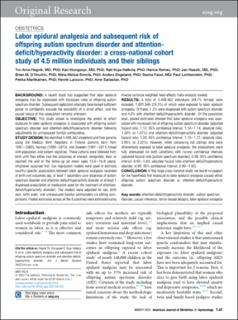| dc.description.abstract | Background
A recent study has suggested that labor epidural analgesia may be associated with increased rates of offspring autism spectrum disorder. Subsequent replication attempts have lacked sufficient power to confidently exclude the possibility of a small effect, and the causal nature of this association remains unknown.
Objective
This study aimed to investigate the extent to which exposure to labor epidural analgesia is associated with offspring autism spectrum disorder and attention-deficit/hyperactivity disorder following adjustments for unmeasured familial confounding.
Study Design
We identified 4,498,462 singletons and their parents using the Medical Birth Registers in Finland (cohorts born from 1987–2005), Norway (1999–2015), and Sweden (1987–2011) linked with population and patient registries. These cohorts were followed from birth until they either had the outcomes of interest, emigrated, died, or reached the end of the follow-up (at mean ages 13.6–16.8 years), whichever occurred first. Cox regression models were used to estimate country-specific associations between labor epidural analgesia recorded at birth and outcomes (eg, at least 1 secondary care diagnosis of autism spectrum disorder and attention-deficit/hyperactivity disorder or at least 1 dispensed prescription of medication used for the treatment of attention-deficit/hyperactivity disorder). The models were adjusted for sex, birth year, birth order, and unmeasured familial confounders via sibling comparisons. Pooled estimates across all the 3 countries were estimated using inverse variance weighted fixed-effects meta-analysis models.
Results
A total of 4,498,462 individuals (48.7% female) were included, 1,091,846 (24.3%) of which were exposed to labor epidural analgesia. Of these, 1.2% were diagnosed with autism spectrum disorder and 4.0% with attention-deficit/hyperactivity disorder. On the population level, pooled estimates showed that labor epidural analgesia was associated with increased risk of offspring autism spectrum disorder (adjusted hazard ratio, 1.12; 95% confidence interval, 1.10–1.14, absolute risks, 1.20% vs 1.07%) and attention-deficit/hyperactivity disorder (adjusted hazard ratio, 1.20; 95% confidence interval, 1.19–1.21; absolute risks, 3.95% vs 3.32%). However, when comparing full siblings who were differentially exposed to labor epidural analgesia, the associations were fully attenuated for both conditions with narrow confidence intervals (adjusted hazard ratio [autism spectrum disorder], 0.98; 95% confidence interval, 0.93–1.03; adjusted hazard ratio attention-deficit/hyperactivity disorder, 0.99; 95% confidence interval, 0.96–1.02).
Conclusion
In this large cross-national study, we found no support for the hypothesis that exposure to labor epidural analgesia causes either offspring autism spectrum disorder or attention-deficit/hyperactivity disorder. | en_US |

